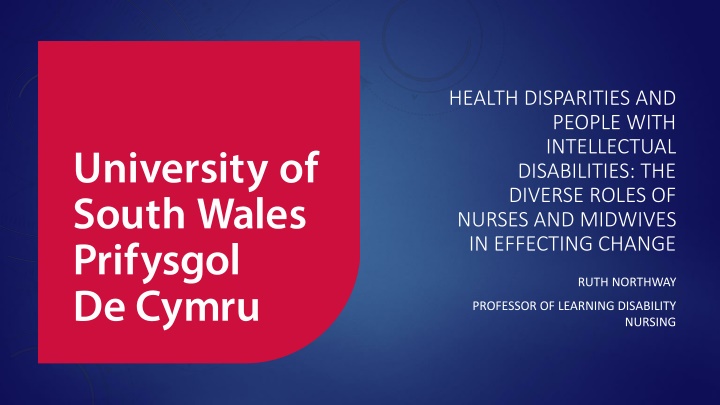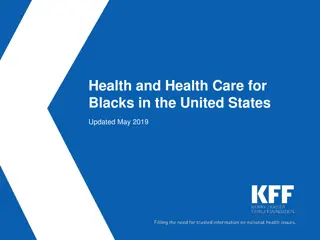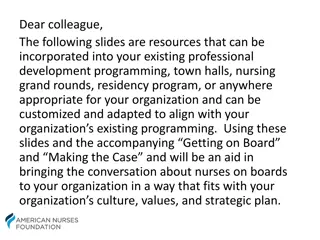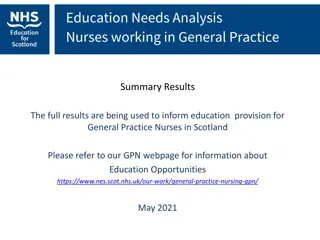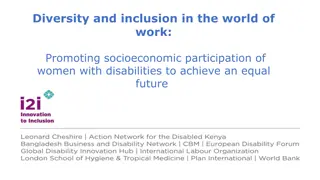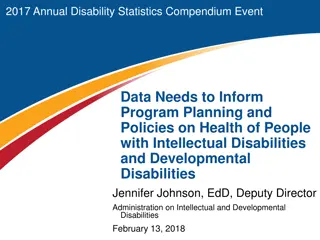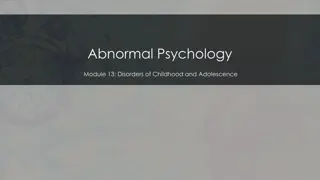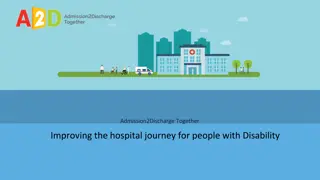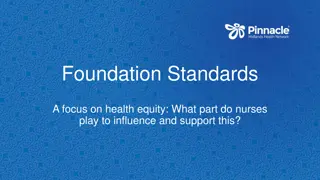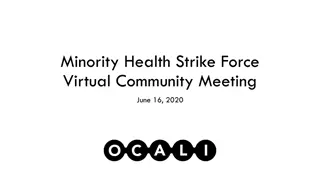Addressing Health Disparities in People with Intellectual Disabilities: Roles of Nurses and Midwives
People with intellectual disabilities face significant health disparities, including multiple long-term health conditions and higher mortality rates. Nurses and midwives play diverse roles in addressing these disparities through research and inclusive practices. Common conditions include epilepsy, obesity, and heart disorders. In Ireland, respiratory, gastrointestinal, and neurological issues top the list of reasons for hospital admissions. Gender and ethnicity also play a role in health experiences, with women and certain ethnic groups facing higher risks. Understanding these disparities is crucial for providing effective care and promoting better health outcomes for individuals with intellectual disabilities.
Download Presentation

Please find below an Image/Link to download the presentation.
The content on the website is provided AS IS for your information and personal use only. It may not be sold, licensed, or shared on other websites without obtaining consent from the author.If you encounter any issues during the download, it is possible that the publisher has removed the file from their server.
You are allowed to download the files provided on this website for personal or commercial use, subject to the condition that they are used lawfully. All files are the property of their respective owners.
The content on the website is provided AS IS for your information and personal use only. It may not be sold, licensed, or shared on other websites without obtaining consent from the author.
E N D
Presentation Transcript
HEALTH DISPARITIES AND PEOPLE WITH INTELLECTUAL DISABILITIES: THE DIVERSE ROLES OF NURSES AND MIDWIVES IN EFFECTING CHANGE RUTH NORTHWAY PROFESSOR OF LEARNING DISABILITY NURSING
The health disparities experienced by people with intellectual disabilities The diversity within the population of people with intellectual disabilities AREAS TO BE EXPLORED The diverse roles and responsibilities of all nurses in midwives in addressing these disparities The part that research can play in supporting this process and the need for inclusive research
HEALTH DISPARITIES AND PEOPLE WITH INTELLECTUAL DISABILITIES Commonly experienced conditions epilepsy, ear and eye disorders, cerebral palsy, obesity, osteoporosis, congenital heart disorders and thyroid disorders (Liao et al, 2021) Often experience multi-morbidity and often at a younger age than non-disabled peers. In one study of people with intellectual disabilities aged 50+ it was was found that 79.9% were living with multimorbidity and 46.8% were living with four or more long term health conditions (Hermans and Evenhuis, 2014) On average die 20 years earlier than non-disabled peers (O Leary et al, 2018) When compared with the wider population people with intellectual disabilities are 3 times more likely to die from an avoidable medical cause with most of this excess risk being due to treatable medical causes of death (LeDER, 2021) Respiratory and circulatory diseases the most common cause of death whilst deaths due to cancer fewer than the wider population and the cancer profile differs from the wider population (O Leary et al, 2018)
PRESENTING PROBLEMS/ CONDITIONS THAT RESULT IN PEOPLE WITH AN INTELLECTUAL DISABILITY BRING ADMITTED TO HOSPITALS IN THE REPUBLIC OF IRELAND (DOODY ET AL, 2022) January 2016 December 2020 there were 16998 admissions to acute care of people identified as having an intellectual disability Top presenting physical health problems: Respiratory Gastro-intestinal (including dental) Neurological ENT Cardiac Type of admission Elective/ elective readmissions 52.7% Emergency / readmissions 41.7% Newborn / maternity 5.6%
DIVERSE HEALTH EXPERIENCES Gender O Leary et al (2018) systematic review inequality in mortality rates between people with intellectual disabilities and the wider population is greater for women than for men. Ethnicity LeDeR (2021) found that for those people with intellectual disabilities of Asian/ British Asian ethnicity the risk of dying aged 18 49 was nine times greater than for their White British peers Nature of intellectual disability People with profound or multiple learning disabilities are 6.4 times more likely to die between the ages of 18 - 49 than someone with a mild learning disability (LeDeR, 2021)
INEQUALITIES OR INEQUITIES? Equality of what? Treatment? Access? Outcomes? Whitehead (1991) not all differences in health status are avoidable. However, where they are unnecessary, avoidable, unfair or unjust then inequities exist Inequities can and should be addressed
IMPLICATIONS FOR NURSES AND MIDWIVES? Only minority of people with intellectual disabilities are known to specialist learning disability services Hatton et al (2016) estimate only approximately 23% All nurses and midwives are involved in supporting people with intellectual disabilities accessing healthcare As the largest healthcare workforce we have the potential to make a significant difference but: There are a number of barriers
BARRIERS Communication Lack of confidence and competence Lack of awareness Research can have a practical impact on identifying and addressing these barriers
Developing Guidance for Social Workers Supporting Families Where a Parent has an Intellectual Disability (Northway, Culwick, Kent, Rees and Genders) HIGHLIGHTING EXPERIENCES INCREASING UNDERSTANDING They listen to professionals but not me. I told the school, the doctor and the social worker. they did not diagnose him till 9 and I told them for years and years and years. (Parent 8) Then the midwife taught me when I came home to do bottles and feeding. I asked her to show me how to do things. She was there all day, and she taught me how to sterilise I had all the support that I needed, but I think I needed that little bit of help. (Parent 9)
LEARNING DISABILITY EDUCATIONAL FRAMEWORK FOR HEALTHCARE STAFF IN WALES (NORTHWAY, OLOIDI, MORGAN, PRICE AND CHURCHER, 2020) Reviewed literature and existing educational frameworks Undertook semi-structured interviews with a range of key stakeholders (n=22) Consultation with our Teaching and Research Advisory Committee (TRAC) Key values rights, equality, person centred Key principles shared responsibility, collaboration and partnership, a lifespan approach
LEARNING DISABILITY EDUCATIONAL FRAMEWORK FOR HEALTHCARE STAFF IN WALES (NORTHWAY, OLOIDI, MORGAN, PRICE AND CHURCHER,2020) 2020) Key areas of knowledge and skills Understanding learning disability The health needs of people with intellectual disabilities Recognising and removing barriers to healthcare Understanding and responding to behaviour Communication Coordination and collaboration Legal and policy issues Three levels foundation, enhanced and advanced Foundation level used as the basis for mandatory training
PROMOTING COMMUNICATION Hospital passports widely promoted Reports of variable use Analysis of 60 documents (Northway, Rees, Davies, Williams, 2017) Variation in terms of length, content and format Potential patient safety concern Advocated development of a single tool
ONCE FOR WALES HEALTH PROFILE (NORTHWAY, REES AND OLOIDI, 2020) On-line survey Focus groups Stakeholder consultation
ONCE FOR WALES HEALTH PROFILE Developed health communication tool and guidance documents Launched June 2020 Focus on implementation and awareness raising Social media campaign Peer education
REDUCING HEALTH DISPARITIES: THE IMPORTANCE OF RESEARCH, NURSING AND MIDWIFERY Need Need to ensure that available research is translated into practice Need Need to develop inclusive research Need to promote the inclusion of people with learning disabilities in wider research Need
IMPLICATIONS THERE ARE ETHICAL CHALLENGES TO ENSURE SUCH INCLUSION BUT ALSO ETHICAL IMPLICATIONS OF EXCLUSION NEED TO CONSIDER HOW WE DO RESEARCH AND MAKE ADJUSTMENTS TO PROMOTE INCLUSION IMPORTANCE OF WORKING IN PARTNERSHIP
IN CLOSING All nurses and midwives, working in all settings, can make a difference to the health disparities experienced by people with intellectual disabilities Do you accept this challenge to promote more inclusive healthcare that meets diverse needs?
Ruth Northway Email : ruth.northway@southwales.ac.uk CONTACT Twitter: @northwayruth
REFERENCES Doody, O. et al (2021) Presenting problems/ conditions which result in people with an intellectual disability being admitted to acute hospitals in the Republic of Ireland: An analysis of NOAIS clinical data from 2016 2020, Limerick: University of Limerick and Office of the Nursing and Midwifery Director, Health Service Executive, Ireland Hatton, C., Glover, G., Emerson, E., Brown, I. (2016) People with Learning Disabilities in England 2015: Main Report, https://assets.publishing.service.gov.uk/government/uploads/system/uploads/attachment_data/file/61 3182/PWLDIE_2015_main_report_NB090517.pdf Hermans, H., Evenhuis, H.M. (2014) Multimorbidity in older adults with intellectual disabilities, Research in Developmental Disabilities, 35, 776 783 LeDeR (2021) Annual Report 2020, http://www.bristol.ac.uk/media- library/sites/sps/leder/LeDeR%20programme%20annual%20report%2013.05.2021%20FINAL.pdf
REFERENCES Improvement Cymru (2020) Once for Wales Health Profile https://phw.nhs.wales/services-and- teams/improvement-cymru/our-work/learning-disability-health-improvement-programme/health- profile/health-profile-for-professionals/ Liao, P., Vajdic, C., Troller, J., Reppermund, S. (2021) Prevalence and incidence of physical health conditions in people with intellectual disability a systematic review, PLoS ONE, 16 (8): e0256294. https://doi.org/10.1371/journal.pone.0256294 Northway, R. et al (2020) Learning Disability Educational Framework for Healthcare Staff in Wales, https://phw.nhs.wales/services-and-teams/improvement-cymru/news-and-blog/publications/learning- disability-educational-framework/ O Leary, L., Cooper, S.A., Hughes-McCormack, L. (2018) Early death and causes of death of people with intellectual disabilities: A systematic review, Journal of Applied Research in Intellectual Disabilities, 31, 325 - 342
